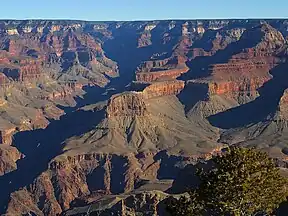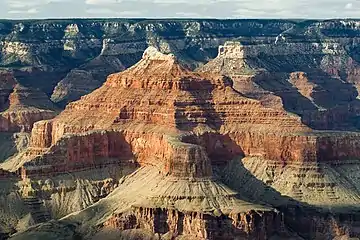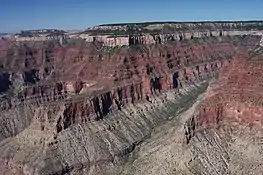| Bright Angel Shale | |
|---|---|
| Stratigraphic range: Middle Cambrian [1] | |
 Muav Limestone – (dark or light gray, brown, or orange-red subcliff at base of Redwall Limestone cliff) and Bright Angel Shale (greenish slope-former), resting on Tapeats Sandstone (short, dp brown vertical cliff) (Tapeats forms the "Tonto Platform"), inner canyon, Granite Gorge. (The 3 units – Muav, Bright Angel, and Tapeats, are easily seen below the red-stained Redwall Limestone (550 feet (170 m) thick) | |
| Type | Geological formation |
| Unit of | Tonto Group[2] |
| Underlies | Muav Limestone |
| Overlies | Tapeats Sandstone |
| Thickness | 500 feet (150 m) at its maximum |
| Lithology | |
| Primary | micaceous siltstone and shale |
| Other | sandstone and glauconitic sandstone |
| Location | |
| Region | northern Arizona, southeast California, southern Nevada, and southcentral Utah |
| Country | United States of America |
| Type section | |
| Named for | Bright Angel Canyon, Bright Angel quadrangle, Coconino Co., Arizona[3] |
| Named by | Noble (1914)[3] |
The Bright Angel Shale is one of five geological formations that comprise the Cambrian Tonto Group. It and the other formations of the Tonto Group outcrop in the Grand Canyon, Arizona, and parts of northern Arizona, central Arizona, southeast California, southern Nevada, and southeast Utah. The Bright Angel Shale consists of locally fossiliferous, green and red-brown, micaceous, fissile shale (mudstone) and siltstone with local, thicker beds of brown to tan sandstone and limestone. It ranges in thickness from 57 to 450 feet (17 to 137 m). Typically, its thin-bedded shales and sandstones are interbedded in cm-scale cycles. They also exhibit abundant sedimentary structures that include current, oscillation, and interference ripples. The Bright Angel Shale also gradually grades downward into the underlying Tapeats Sandstone. It also complexly interfingers with the overlying Muav Limestone. These characters make the upper and lower contacts of the Bright Angel Shale often difficult to define. Typically, its thin-bedded shales and sandstones erode into green and red-brown slopes that rise from the Tonto Platform up to cliffs formed by limestones of the overlying Muav Limestone and dolomites of the Frenchman Mountain Dolostone.[2][4]
Nomenclature
In 1875, G. K. Gilbert[5] recognized that strata exposed near the bottom of parts of the Grand Canyon are similar to those known elsewhere in Arizona as the Tonto Group. Based upon this similarity, he assigned the strata that form the lowermost part of the Phanerozoic strata in the Grand Canyon to the Tonto Group. Without designating formal type localities, he also subdivided the Tonto Group into three subdivisions, from youngest to oldest, the Marbled limestone, the Tonto shale, and the Tonto sandstone.[5]
In 1914, L F. Noble[3] renamed Gilbert's subdivisions of the Tonto Group. He renamed the Tonto sandstone as the Tapeats Sandstone and the Tonto shale as the Bright Angel Shale. He named the Bright Angel Shale after Bright Angel Canyon because in the walls of this canyon, this formation is well exposed.[3]
Later in 1922,[6] the Marbled limestone was redefined and renamed as the Muav Limestone by L. F. Noble. According to Noble's definition, the Muav Limestone consisted of an upper set of dolomite beds and a lower set of limestone beds.[6] Noble's lower set of limestone beds is now defined as the Muav Limestone and the Frenchman Mountain Dolostone is now defined as Noble's upper set of dolomite beds.[4]
E. D. McKee and C. E. Resser[7] largely retained Noble's nomenclature. However, they did subdivide the Bright Angel Shale into a number of subdivisions, members, based upon prominent beds of limestone and sandstone within it. However, these members have found to be confusing and unhelpful in understanding the stratigraphy of the Bright Angel Shale and are typically ignored and rarely used in the published literature.[8][9]
Description
In the Grand Canyon, the Bright Angel Shale is typically a heterogenous, sometimes fossiliferous, mixture of interbedded shale, mudstone, siltstone, fine-grained sandstone, and isolated beds of limestone. The dominant lithology within the Bright Angel Shale is greenish shale that is composed largely of illite and varying amounts of chlorite and kaolinite. A reddish brown coloration is imparted to a number of the sandstone and siltstone beds by the high percentage of hematitic ooids and iron oxide cements that they contain. Isolated beds of coarse-grained sandstone with either basal conglomerate or conglomeratic sandstone also locally occur within the Bright Angel Shale. The gravel fraction of these beds contain quartz, minor amounts of potassium feldspars, sedimentary rock fragments, and glauconite. Glauconite also occurs in and imparts a greenish color to many of the siltstones and sandstones. Towards its base, the Bright Angel Shale becomes increasingly coarser with increasing frequency of sandstone beds until it grades gradually into the Tapeats Sandstone.[2][4][7]
The siltstones and sandstones of the Bright Angel Shale exhibit sedimentary structures throughout the Grand Canyon. These sedimentary structures include horizontal laminations, small- to large-scale planar tabular and trough cross-stratification, and wavy and lenticular bedding. The isolated coarse-grained and conglomeratic sandstones are typically structureless and crudely stratified and overlie a locally scoured surface.[2][4][7]
In the Grand Canyon, the Bright Angel Shale is generally about 350 to 500 feet (110 to 150 m) thick. In the western Grand Canyon, the Bright Angel Shale is over 450 feet (140 m) thick and decrease eastward in thickness to only about 270 feet (82 m) at Toroweap in the central canyon. It is 325 feet (99 m) thick in Bright Angel Canyon. The complex interfingering of the Bright Angel Shale with the overlying Muav Limestone is the main cause of the variability in its thickness. South the Grand Canyon, decreases in thickness only a few feet thick in the Juniper Mountains north of Prescott, Arizona.[2][4][7]
Fossils
Within the Grand Canyon, the Bright Angel Shale is the most fossiliferous of the five formations that comprise the Tonto Group. It contains a variety of body fossils and is rich in trace fossils. Overall, when compared with other Middle Cambrian formations in the region, the Bright Angel Shale body fossils are fragmentary and rare. Although it is relatively barren regionally of body fossils, individual beds can be rich in complete body fossils. Individual beds within the Bright Angel Shale are as productive as many of the other Cambrian formations in the Great Basin and Rocky Mountain regions. The Bright Angel Shale has yielded at least 15 species of trilobites and four genera of brachiopods. In addition, one genus of hyoliths, four genera of possible marine arthropods, and two species of eocrinoids have been found in it.[10]
The trace fossils found in the Bright Angel Shale consist of arthropod tracks and trails, worm burrows, and dwelling structures. Some of these have been identified at the ichnogenus and ichnospecies level. In addition, wrinkle structures have been found within the Bright Angel Shale in the Sumner Butte area. They are classified as microbially induced sedimentary structures.[11][12]
Depositional setting
Initially, the Bright Angel Shale, largely on the presence of glauconite, was regarded to have accumulated within the deeper part of a marine shelf.[7] Later, the Bright Angel Shale is typically interpreted as a shallow marine shelf unit and its various members are interpreted to be to minor transgressions and regressions.[2] However, parts of it have also been more recently interpreted as including estuary and tidal flat settings influenced by storm events. This interpretation is based on the type of cross-bedding in sandstones and presence of wavy or lenticular heterolithic bedding, both of which indicate a changing tidal environment.[4][11] Finally, the lack of acritarchs in the shales, the dominant lithology of the formation is regarded as evidence for minimal marine influence during their deposition.[12] Isolated shale beds within the Bright Angel Shale that contain a well preserved and diverse fauna of trilobites, brachiopods and others fossils likely represent periods of shallow marine shelf deposition during periods of high, relative sea levels in the Grand Canyon region.[10]
Age
In 1945, E. D. McKee and C. E. Resser[7] used trilobite fossil assemblages to determine age of the Bright Angel Shale. They interpreted the trilobite biostratigraphy to indicate that it crosses time lines and becomes younger toward the east. In their interpretation, the base of the Bright Angel Shale and its lower third of it is late Early Cambrian whereas in the eastern part of the canyon its base and entire thickness is Middle Cambrian.[2] In 2018, K. Karlstrom and others[13] found that the Tapeats Sandstone is younger than previously interpreted and does not get younger to the east. As a result, the Bright Angel Shale lies entirely in the Middle Cambrian.[1][11]
The units of the Tonto Group and the colorful Bright Angel Shale are easily identified as a geological sequence beneath the tall cliffs of the Redwall Limestone (the Redwall sits upon a short resistant cliff of Muav Limestone); the Tonto Group is also easily seen beside Granite Gorge of the Colorado River and the Vishnu Basement Rocks
See also
References
- 1 2 Karlstrom, K.E., Mohr, M.T., Schmitz, M.D., Sundberg, F.A., Rowland, S.M., Blakey, R., Foster, J.R., Crossey, L.J., Dehler, C.M. and Hagadorn, J.W., 2020. Redefining the Tonto Group of Grand Canyon and recalibrating the Cambrian time scale. Geology, 48(5), pp. 425–430.
- 1 2 3 4 5 6 7 Middleton, L.T. and Elliott, D.K., 2003. Tonto Group, in Beus, S. S., and Morales, M., eds. Grand Canyon geology Museum of Northern Arizona Press, Flagstaff, Arizona. pp. 90–106.
- 1 2 3 4 Noble, L.F., 1914. The Shinumo quadrangle, Grand Canyon district, Arizona. U.S. Geological Survey Bulletin. 549. doi:10.3133/B549. ISSN 0083-1093.
- 1 2 3 4 5 6 Connors, T.B., Tweet, J.S., and Santucci, V.L., 2020. Stratigraphy of Grand Canyon National Park. In: Santucci, V.L., Tweet, J.S., ed., pp. 54–74, Grand Canyon National Park: Centennial Paleontological Resource Inventory (Non-sensitive Version) . Natural Resource Report NPS/GRCA/NRR—2020/2103. National Park Service, Fort Collins, Colorado, 603 pp.
- 1 2 Gilbert, G.K., 1875. Report upon the geology of portions of Nevada, Utah, California, and Arizona, Chapter 6. In Wheeler, G.M., ed., pp. 17–187, Report on the Geographical and Geological Explorations and Surveys West of the One Hundredth Meridian, vol. 3. U.S. Geological and Geographical Survey, Publication of the Wheeler Survey, Washington, D.C., 681 pp.
- 1 2 Noble, L.F., 1922. A section of the Paleozoic formations of the Grand Canyon at the Bass Trail. U.S. Geological Survey Bulletin. 131-B, pp. 23–73
- 1 2 3 4 5 6 McKee, E.D., and Resser, C.E., 1945, Cambrian history of the Grand Canyon region. Carnegie Institution of Washington Publication 563, 168 pp.
- ↑ Huntoon, P.W., 1977. Cambrian stratigraphic nomenclature and ground‐water prospecting failures on the Hualapai Plateau, Arizona. Groundwater, 15(6), pp.426-433.
- ↑ Huntoon, P. W. (1989). Cambrian stratigraphic nomenclature, Grand Canyon, Arizona: Mappers nightmare, in Elston, D.P., Billingsley, G.H., and Young, R.A., eds. Geology of Grand Canyon, northern Arizona (with Colorado River guides): Lees Ferry to Pierce Ferry, Arizona. Field trips for the 28th international geological congress. Museum of Northern Arizona Press, Flagstaff, Arizona. pp. 128–129. doi:10.1029/FT115p0128
- 1 2 Foster, R.J., 2011. Trilobites and other fauna from two quarries in the Bright Angel Shale (Middle Cambrian, Series 3; Delamaran), Grand Canyon National Park, Arizona. in Hollingsworth, J.S., Sundberg, F.A. & Foster, J.R., eds. Cambrian Stratigraphy and Paleontology of Northern Arizona and Southern Nevada. Museum of Northern Arizona Bulletin, 67:99–120.
- 1 2 3 Miller, A.E., Marchetti, L., Francischini, H., Lucas, S.G., 2020. Paleozoic invertebrate ichnology of Grand Canyon national Park. In: Santucci, V.L., Tweet, J.S., ed., pp. 277–331, Grand Canyon National Park: Centennial Paleontological Resource Inventory (Non-sensitive Version) . Natural Resource Report NPS/GRCA/NRR—2020/2103. National Park Service, Fort Collins, Colorado, 603 pp.
- 1 2 Baldwin, C.T., Strother, P.K. , Beck, J.H. , and Rose, E., 2004. Palaeoecology of the Bright Angel Shale in the eastern Grand Canyon, Arizona, USA, incorporating sedimentological, ichnological and palynological data. In: D. McIlroy, ed., pp. 213-236. The application of ichnology to palaeoenvironmental and stratigraphic analysis. Special Publications 228. Geological Society of London, London, United Kingdom.
- ↑ Karlstrom, K., Hagadorn, J., Gehrels, G., Matthews, W., Schmitz, M., Madronich, L., Mulder, J., Pecha, M., Giesler, D. and Crossey, L., 2018. Cambrian Sauk transgression in the Grand Canyon region redefined by detrital zircons. Nature Geoscience, 11(6), pp.438-443.
Further reading
- Blakey, Ron and Wayne Ranney, Ancient Landscapes of the Colorado Plateau, Grand Canyon Association (publisher), 2008, 176 pages, ISBN 978-1934656037
- Brandriss, M. (2004) Angular unconformity between Proterozoic and Cambrian rocks, Grand Canyon, Arizona. GeoDIL, A Geoscience Digital Image Library, University of North Dakota, Grand Forks, North Dakota.
- Mathis, A., and C. Bowman (2007) The Grand Age of Rocks: The Numeric Ages for Rocks Exposed within Grand Canyon, Grand Canyon National Park, Arizona, National Park Service, Grand Canyon National Park, Arizona.
- Share, J. (2102a) The Great Unconformity of the Grand Canyon and the Late Proterozoic-Cambrian Time Interval: Part I – Defining It.
- Share, J. (2102a) The Great Unconformity and the Late Proterozoic-Cambrian Time Interval: Part II - The Rifting of Rodinia and the "Snowball Earth" Glaciations That Followed.
- Timmons, M. K. Karlstrom, and C. Dehler (1999) Grand Canyon Supergroup Six Unconformities Make One Great Unconformity A Record of Supercontinent Assembly and Disassembly. Boatman's Quarterly Review. vol. 12, no. 1, pp. 29–32.
- Timmons, S. S. (2003) Learning to Read the Pages of a Book (Grand Canyon Geology Training Manual), National Park Service, Grand Canyon National Park, Arizona.


